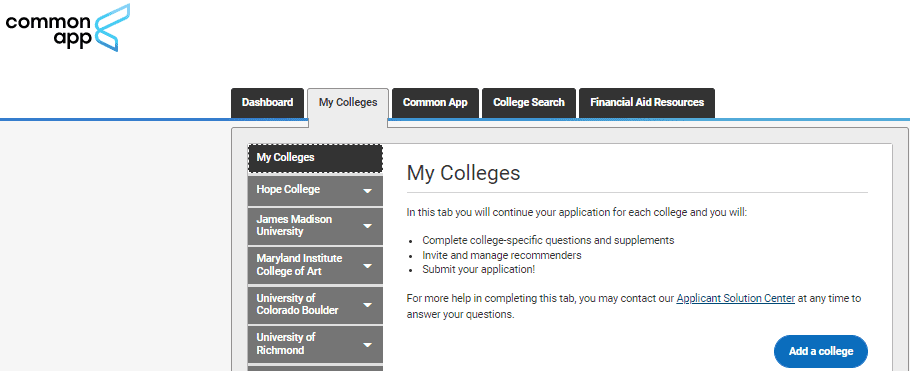This one is for my seniors and the adults who are trying to help them navigate the application process.
Every year, I meet with seniors several times to help get their applications completed and I walk them through the steps for submitting them. But over the years, I’ve learned that the process is kind of like running a steeplechase: each step feels like an obstacle of varying difficulty, and when you’re focused on the hurdle right in front of you, it’s difficult to process instructions about the water jump that’s several barriers ahead. (Sports fans, I apologize for using a metaphor for something I watched once during an Olympics many years ago.)
steps for submitting them. But over the years, I’ve learned that the process is kind of like running a steeplechase: each step feels like an obstacle of varying difficulty, and when you’re focused on the hurdle right in front of you, it’s difficult to process instructions about the water jump that’s several barriers ahead. (Sports fans, I apologize for using a metaphor for something I watched once during an Olympics many years ago.)
So I’m writing this post as another guide and reference point you can use to make sure you remember everything.
Keep in mind that these steps are NOT in any particular order. Materials can be sent to colleges in any order, and you have to plan ahead for some of them. I’d recommend starting your application and essays well before the two-week point I start the checklist with–but you don’t actually have to submit them until the deadline.
Below, I describe each step in detail, but here’s a simplified checklist you can print and keep handy (seniors, there’s one of these in the folder I gave you . . . if you can still find it). College application checklist
At least two weeks before the college deadline:
- Sign the FERPA Authorization and Waiver of Rights in Scoir and the Common App (if you’re using it). This only has to be done once on each platform and then it will apply to all colleges. This gives us permission to release your transcripts and promises colleges that you won’t see your letters of recommendation (so they are assured the letters are honest and confidential). If you came to one of my application workshops or paid attention to my presentation in Gov’t class, I walked you through this step.
- Request a teacher recommendation letter. You must allow at least two weeks for a teacher to write their recommendation, but it’s best to give them more. The best letters are written by people who aren’t worrying about a deadline. You probably only need one letter, but check each college’s requirements. You might need two, or you might not need any! Each letter is written generally (not to a specific college), so that letter can be sent to all your colleges.
- Fill out the purple request form. Ask your teacher personally to write the letter and hand them the form.
- Request the recommendation through Scoir, so your teacher can upload the letter. (In the “My Colleges” tab, click “Manage Documents.”)
- Move the colleges you’re applying to into the “Applied” column in Scoir. It streamlines our process if you do this before you request transcripts, and it’s okay to take this step before you have actually applied.
- Request your transcripts to be sent. You must complete this form for every college you want a transcript sent to.
- Click HERE or use the QR Code on the checklist I linked above for the Transcript Request Form.
- You need to know whether you need a counselor recommendation for each college–this document also serves as your request for a counselor letter–check the college websites! Please don’t ask me to write a letter if the college doesn’t want one.
- If you plan to submit test scores, check the college website to see if you can simply self-report scores (which you do in the application) or if they need to receive official scores. If they need the official scores, you must go to your account on College Board or ACT to have them sent.
- International students: If English is not your first language, you will likely need test scores confirming English proficiency. Some colleges waive this requirement if you had two or more years of high school in the US or if you scored over 500 on the EBRW section of the SAT. They may require a certain score on a Duolingo test or the TOEFL. (If they accept Duolingo, I highly recommend it over TOEFL–it’s cheaper and you don’t have to drive to a testing center, but can do it on your computer at home.)
- Optional: If you want me to review your essay or answers to supplemental questions, send them to me at least a week or two before you need to submit your application.
Before the college deadline (You can complete this two months or one day before the deadline, but please don’t wait until 11:25 on the night it’s due–if something goes wrong, you’re sunk):
- Complete and submit the application! Seems obvious, right? But this most crucial step takes a long time, and you might start it before you do anything else. Also . . . it’s difficult to believe, but I’ve had students complete everything on the app and then forget to actually submit it.
- Know whether you’re completing the Common App or a college-specific app.
- Use the College Application Guide (linked here, also in the folder I gave you) as you work–the answers to many questions you’ll have will be found there. College Application Guide 2021-22
- On Common App, you need to complete the general application and then the college-specific part, which will have several sections of questions and could have supplemental writing–and the writing questions are sometimes difficult to find (sometimes they’ll be in the “writing supplement” section but often they’re
 found in the “academics” portion). Allow enough time to answer those questions well–they’re just as important as the Common App essay.
found in the “academics” portion). Allow enough time to answer those questions well–they’re just as important as the Common App essay. - Make sure to use your full legal name on all documentation and give colleges your personal email address, not your emhs.net address, which won’t exist after you graduate.
- Review, enter your credit card information (unless it’s a free application), click submit, and then celebrate!
- Check for other required materials.
- Some colleges (Virginia Tech, cough, cough) require an SRAR (or SSAR, in Florida)–a self-reported academic record. In other words, you translate your transcripts into their form rather than having us send them. Usually, you apply first, then you’ll receive instructions on creating your student portal and accessing the SRAR, which will allow the college to link your application to the SRAR.
- If you are applying for a visual or performing arts program/college, you’ll likely need to audition or submit a portfolio. Read the college’s website carefully for deadlines and instructions.
- Complete required financial aid documentation. This might not be due until after the college deadline, but you need to check! It depends on each college.
- The FAFSA is required for all federal student aid and for most colleges if you want to qualify for grants or loans.
- Some colleges also require the CSS Profile, which is much more time-consuming and detailed.
After you apply:
- Check your email for a confirmation of your application from the college and instructions for setting up your student portal. This is where you can check to see that all your materials have been received, and often, colleges announce their decisions on your portal before you get notice via email or snail mail.
- Remember: Do not use your emhs.net address when setting up your student portal! It could cause much confusion after you graduate and that address no longer exists.
- The student portal is important! Colleges will post information regarding housing, health, and other forms you must complete. There might also be instructions for additional materials you need to submit (report cards, SRARs, etc.).
- Keep in mind that it can take several business days for documentation to be processed, so don’t panic if the portal indicates that your transcript hasn’t been received. Check Scoir to see if it was sent, then give it several days. If it still doesn’t show up, let me know and I’ll follow up with the college.
- Write a thank-you note to the teacher(s) who wrote your recommendations.
That’s it! Easy, right? 🤯 Don’t worry. I know it feels like a lot, but keep in mind that not every step applies to every application, and there are several things you only need to do once. And don’t forget I’m here to help you every step of the way.

